enforex_pages_landing_block_222bb490-5a01-4caf-a1cf-064287b4fdd3
Spanish is either a fast language or Spanish speakers just talk faster; at least that’s what linguists and researchers are saying. Last year researchers from University of Lyon carried out a study on 59 native speakers from different countries and found out that Spanish was the second fastest language.
As a learner you might notice that Spanish is a strong and passionate language that is rich in expressions. Beginners may find that proper pronunciation can get a little bit difficult. Finding the correct vowel to stress or pronouncing “George” as “Jorge” or the “r” as “rr” will take a little time to get used to.
Based on the study conducted by SpinVox (an American company integrating speech technology into human intelligence), the worst pronounced Spanish word is “viniste” usually mistaken with “veniste”. The second word is “trastorno” pronounced as “transtorno”, as it seems people mistakenly follow pronunciation patterns set by similar words like ‘transporte’ and “transcripción”.
Another fact that this study has revealed is that not being able to pronounce certain words in the right way often makes Spanish speakers laugh or simply amuses the person he or she is talking to. 47% of Spanish learners said they were embarrassed when they couldn’t pronounce a word correctly, and one in five respondents admitted feeling uncomfortable if their conversation partner was having difficulties with pronunciation. In addition, more than half of those questioned said they try to avoid using words that are difficult to pronounce to avoid looking funny while 43% of people admitted that they correct someone who makes pronunciation mistakes. In fact, having someone correct our pronunciation mistakes is the best way to learn Spanish, as many words are hard to say and when we try to pronounce them correctly, we become aware of how we actually talk.
Have you ever had difficulty pronouncing Spanish words or, if you are native Spanish speaker, do you correct the people you talk to? Some of the most poorly pronounced Spanish words are shown below. Maybe you can add more words which you think are not often said correctly.
|
Viniste - veniste Trastorno - transtorno Prejuicios - perjuicios Idiosincrasia - idiosincracia Sarpullido - zarpullido Ineptitud - inaptitud Madrid - Madrid Esparadrapo - esparatrapo Helicóptero - helicotero Fortísimo - fuertísimo Valle - Vaya |
Croqueta - cocreta Tortícolis - torticulis Popurrí - pupurri Pobre - probe Restricción - restrincción Haya - Haiga Mahonesa - bayonesa Pamplona - plamplona Solidaridad - sodilaridad Institucionalización - institutonalización Semáfaro - Semáforo |
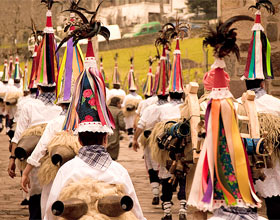 During the final days of January, in the two Navarro towns of Iturren and Zubieta, residents and visitors celebrate a very special Carnival festival. On the 28th and the 29th, the joaldunaks parade about town, wearing very intriguing attire: skirts, sandals, sheep fur over the shoulders and around the waist, colorful scarves around the neck, decorated hats with colorful bands, and enormous bells carried on the back, bells whose ancestral chime drives away evil spirits and awakes the land after its winter slumber. On Monday, the joaldunaks of Zubieta visit Iturren and on Tuesday those from Iturren travel to Zubieta, covering the 3 kilometers distance that separates the two towns, sporting the special attire and chiming the bells the entire way.
During the final days of January, in the two Navarro towns of Iturren and Zubieta, residents and visitors celebrate a very special Carnival festival. On the 28th and the 29th, the joaldunaks parade about town, wearing very intriguing attire: skirts, sandals, sheep fur over the shoulders and around the waist, colorful scarves around the neck, decorated hats with colorful bands, and enormous bells carried on the back, bells whose ancestral chime drives away evil spirits and awakes the land after its winter slumber. On Monday, the joaldunaks of Zubieta visit Iturren and on Tuesday those from Iturren travel to Zubieta, covering the 3 kilometers distance that separates the two towns, sporting the special attire and chiming the bells the entire way.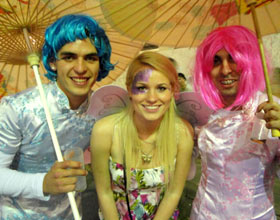 El Puerto de la Cruz, in
El Puerto de la Cruz, in 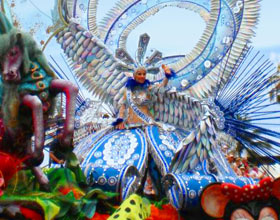 It's no mere coincidence that Santa Cruz de Tenerife celebrates one of the most famous carnival festivals in the world: the striking beauty of the costumes of the Carnival Queen and her court, along with the comparsas and murgas that make their way through town dancing and singing, all make this festival a fantastic spectacle to behold. One of the unique features of the Santa Cruz Carnival Festival is the Carnaval de día (daytime carnival) celebrated days before the
It's no mere coincidence that Santa Cruz de Tenerife celebrates one of the most famous carnival festivals in the world: the striking beauty of the costumes of the Carnival Queen and her court, along with the comparsas and murgas that make their way through town dancing and singing, all make this festival a fantastic spectacle to behold. One of the unique features of the Santa Cruz Carnival Festival is the Carnaval de día (daytime carnival) celebrated days before the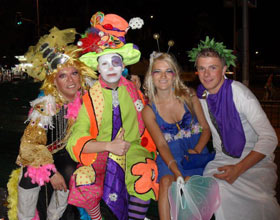 The Carnival Festival of Cadiz is an explosion of joy, humor and music. The chirigotas, murgas, coros and cuartetos (curiously formed by four people) are musical groups that sing their medleys in the Gran Teatro Falla. The groups compete there for a prize, using lyrics loaded with humor and poignant criticism. Later, the groups will take their acts outside, where the streets of the city become their stage. During Carnival time, the city fills with visitors looking for places to hear the fun medleys and enjoy fish tapas and shrimp omelets.
The Carnival Festival of Cadiz is an explosion of joy, humor and music. The chirigotas, murgas, coros and cuartetos (curiously formed by four people) are musical groups that sing their medleys in the Gran Teatro Falla. The groups compete there for a prize, using lyrics loaded with humor and poignant criticism. Later, the groups will take their acts outside, where the streets of the city become their stage. During Carnival time, the city fills with visitors looking for places to hear the fun medleys and enjoy fish tapas and shrimp omelets.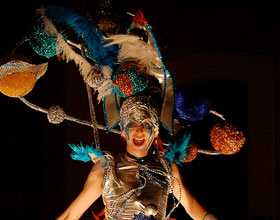 The Tarragona Carnival Festival revolves around the Plaza de la Font, where an enormous wineskin is placed and its contents are offered to Carnival goers. Over the next few days, a Carnival Queen will be elected by representatives of the comparsas that will participate in the parade held on the following Saturday. The morning of "jueves lardero" (the Thursday before Lent), butifarra de huevo (a type of pork sausage with egg) and torta de chicharron (a type of pork flat cake) are shared among Carnival revelers (and there are many) as an appetizer for the election of the queen. The following Tuesday, the city goes into mourning for the entierro de la sardine which finalizes celebrations.
The Tarragona Carnival Festival revolves around the Plaza de la Font, where an enormous wineskin is placed and its contents are offered to Carnival goers. Over the next few days, a Carnival Queen will be elected by representatives of the comparsas that will participate in the parade held on the following Saturday. The morning of "jueves lardero" (the Thursday before Lent), butifarra de huevo (a type of pork sausage with egg) and torta de chicharron (a type of pork flat cake) are shared among Carnival revelers (and there are many) as an appetizer for the election of the queen. The following Tuesday, the city goes into mourning for the entierro de la sardine which finalizes celebrations.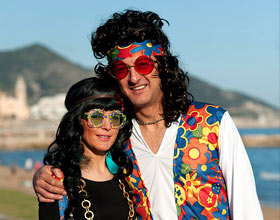 Sitges is a well-known beach destination for tourists. During carnival time however, it transforms into a spectacular scene, where the limitless creativity of the city's celebration can be observed in the "Rúas" (parades), in which moving stages capture your attention and admiration. On "Jueves lardo", his majesty Carnestoltas makes his entrance into the city and gives a speech to the people from town hall (the "predicot"). On Sunday, the Rúa de la Disbauxa is celebrated in all the splendor of Carnival. On the Tuesday of the festival, the Rúa Extermini is held which, unbelievably, has even more participants than the Rúa de la Disbauxa. On Ash Wednesday, the entierro de Carnestoltas (funeral of Carnestoltas) is celebrated, drawing a close to festivities.
Sitges is a well-known beach destination for tourists. During carnival time however, it transforms into a spectacular scene, where the limitless creativity of the city's celebration can be observed in the "Rúas" (parades), in which moving stages capture your attention and admiration. On "Jueves lardo", his majesty Carnestoltas makes his entrance into the city and gives a speech to the people from town hall (the "predicot"). On Sunday, the Rúa de la Disbauxa is celebrated in all the splendor of Carnival. On the Tuesday of the festival, the Rúa Extermini is held which, unbelievably, has even more participants than the Rúa de la Disbauxa. On Ash Wednesday, the entierro de Carnestoltas (funeral of Carnestoltas) is celebrated, drawing a close to festivities.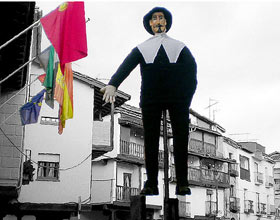 In Villanueva de la Vera, in the province of Cáceres in Extremadura, "el Peropalo" is a central figure of Carnaval celebrations. El Peropalo is a doll that is placed in the town square atop a lance. The doll spins during the days of Carnival until it ends up with its back to town hall. Peropalo is accused and judged for crimes (almost always of a sexual nature) and sentenced. His sentence is displayed on the back of a young person dressed in hideous clothing who rides a donkey about town for the townspeople to inform themselves about the verdict. The festival ends, after several different traditional rituals, on Ash Wednesday, when Peropalo is burnt, as certain mourners lament their loss and miss his favors.
In Villanueva de la Vera, in the province of Cáceres in Extremadura, "el Peropalo" is a central figure of Carnaval celebrations. El Peropalo is a doll that is placed in the town square atop a lance. The doll spins during the days of Carnival until it ends up with its back to town hall. Peropalo is accused and judged for crimes (almost always of a sexual nature) and sentenced. His sentence is displayed on the back of a young person dressed in hideous clothing who rides a donkey about town for the townspeople to inform themselves about the verdict. The festival ends, after several different traditional rituals, on Ash Wednesday, when Peropalo is burnt, as certain mourners lament their loss and miss his favors.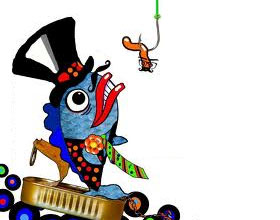 In the beautiful Cantabria city of Santoña, the so-called "Carnaval del norte" (Carnival of the north) is celebrated. Declared a Festival of Touristic Interest, this celebration takes the sea as its theme. Neighbors of the city, great crowds of them, dress up as fish to participate in the festivities. The "juicio del fondo del mar" (judgment at the bottom of the sea) event is held, presided over by Neptune. The Besugo, (Sea Bream, a type fish) is accused of kidnapping a mermaid. Although the Besugo is found innocent, he ends up dying for his love of the mermaid who does not reciprocate his feelings. Festivities draw to a close with his funeral and cremation.
In the beautiful Cantabria city of Santoña, the so-called "Carnaval del norte" (Carnival of the north) is celebrated. Declared a Festival of Touristic Interest, this celebration takes the sea as its theme. Neighbors of the city, great crowds of them, dress up as fish to participate in the festivities. The "juicio del fondo del mar" (judgment at the bottom of the sea) event is held, presided over by Neptune. The Besugo, (Sea Bream, a type fish) is accused of kidnapping a mermaid. Although the Besugo is found innocent, he ends up dying for his love of the mermaid who does not reciprocate his feelings. Festivities draw to a close with his funeral and cremation. The Carnival Festival in Las Palmas de Gran Canaria has emerged with impressive force over the last fifteen years. Although Carnival traditions have a longer history in the neighboring island of Tenerife, Gran Canary residents have created a fiesta that is now on par with that of their neighbors. They have also given it a unique twist, adding a drag-queen ceremony in which a spectacular parade of participants show creativity, choreography and grace worthy of admiration.
The Carnival Festival in Las Palmas de Gran Canaria has emerged with impressive force over the last fifteen years. Although Carnival traditions have a longer history in the neighboring island of Tenerife, Gran Canary residents have created a fiesta that is now on par with that of their neighbors. They have also given it a unique twist, adding a drag-queen ceremony in which a spectacular parade of participants show creativity, choreography and grace worthy of admiration.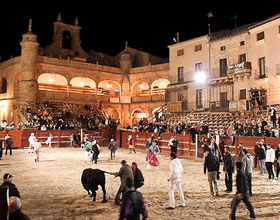 Finally, in the Salamanca countryside, Ciudad Rodrigo celebrates one of the oldest Carnival Festivals in Spain, which centers on the bull as the top of the animal pyramid. The country surrounding the town is one of the areas in which the best bulls are bred, which explains the preponderance of the animal in the festival. The bull fights in Ciudad Rodrigo are well known, and some have a unique feature; bull fighters participate in the event on horseback. A "bull rink" is also installed in the town square, however with the special characteristic of being triangular in shape instead of the usual round form.
Finally, in the Salamanca countryside, Ciudad Rodrigo celebrates one of the oldest Carnival Festivals in Spain, which centers on the bull as the top of the animal pyramid. The country surrounding the town is one of the areas in which the best bulls are bred, which explains the preponderance of the animal in the festival. The bull fights in Ciudad Rodrigo are well known, and some have a unique feature; bull fighters participate in the event on horseback. A "bull rink" is also installed in the town square, however with the special characteristic of being triangular in shape instead of the usual round form.